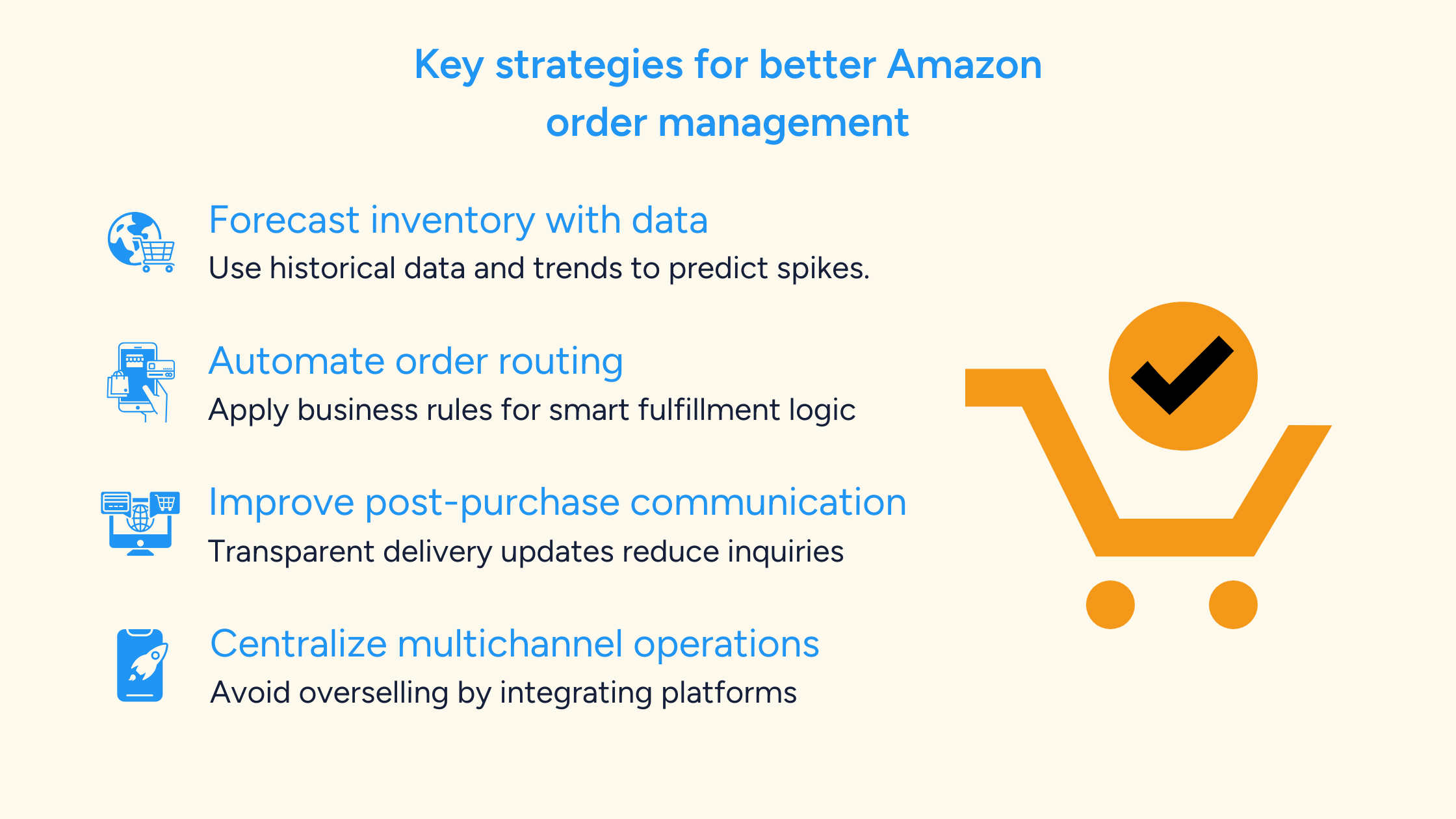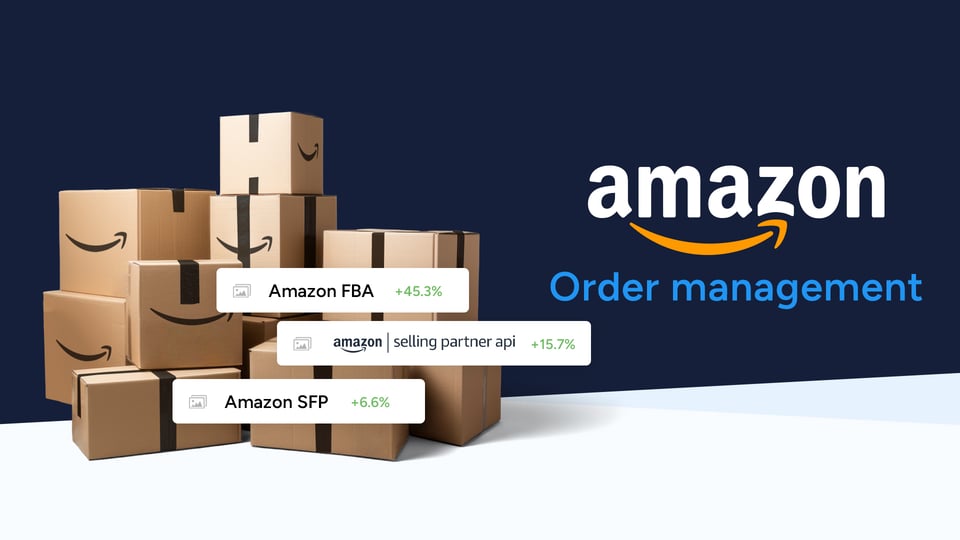Key Takeaways 💡
- Effective order management on Amazon impacts customer satisfaction, operational efficiency, and seller performance.
- The process includes placement, processing, inventory management, fulfillment, shipping, customer service, and returns.
- Sellers can choose between FBA, SFP, FBM, or MCF depending on their fulfillment strategy.
- Common pitfalls include overselling, poor returns handling, ignoring KPIs, relying on manual processes, and failing to plan for peak seasons.
- Amazon’s built-in tools work well for smaller sellers, while larger or multichannel operations benefit from automation and integration software.
- Streamlined order management reduces costs, prevents errors, improves delivery speed, and boosts long-term growth potential.
With ~$1.4 billion in daily sales[1], Amazon is the go-to platform for ecommerce sellers aiming to grow their online presence.
However, if you want to thrive on the vast Amazon marketplace, whether you are a small business owner or an ecommerce veteran, it is imperative to have a robust strategy for managing your orders.
An order management system serves as the backbone of the ordering and fulfillment journey. It helps to ensure a seamless customer journey that promotes brand loyalty, consumer trust, operational efficiency, and continuous revenue streams.
What is Amazon order management?
On Amazon, order management involves overseeing the entire customer order process, from the point of sale to the final delivery. This process is crucial for achieving customer satisfaction, operational efficiency, and overall business success.
While Amazon has its own tools for managing orders, merchants (especially with large volumes or multiple sales channels) often opt for specialized automation software as it helps avoid delays, stockouts, and negative reviews, all of which impact your visibility and sales performance.
For sellers looking to improve operational efficiency, investing in Amazon automation software is a smart move that supports scaling and reduces operational overhead.
Why is Amazon order management important?
Effective Amazon order management directly influences a seller's ability to provide quick, accurate service while maintaining high operational efficiency.
- Efficiency and effectiveness: A seller that automates inventory changes and incorporates real-time data processing ensures that each client order is completed within minutes of being placed. This precision decreases the possibility of stock errors (such as stockouts) and accelerates the entire shipping process, resulting in faster deliveries.
- Customer Satisfaction: A seller can improve transparency and develop confidence by implementing an automated system that keeps customers updated at every stage of their order, from processing to shipping. A consumer who knows exactly when to receive their item is more likely to be satisfied and return buyer.
- Reduced Costs: An accurate order tracking system reduces the possibility of errors, such as sending the incorrect item or quantity. This reduces the need for returns and reshipments while also saving on the additional shipping costs and restocking efforts connected with these issues.
- Speed: Using predictive analytics, a merchant can anticipate demand spikes and prepare by pre-packing the most popular items during peak seasons. This flexibility enables fast dispatch following order confirmation, considerably boosting the number of orders that can be fulfilled daily, resulting in increased income and growth.
A disorganized order process can quickly lead to customer churn, missed revenue, and even account suspension.
 Dex van Hofwegen,
Dex van Hofwegen,Director of Sales & Customer Success
Amazon Order Management:
Step-by-Step Process
1. Order placement
Customers browse Amazon's website or app, select their desired products, and then advance to checkout. The confirmed order is entered into the order management system.
2. Order processing
Following placement, the order is routed to the seller's Amazon Seller Central account. Sellers receive notifications of new orders and begin processing, which involves confirming inventory, prepping products for shipment, and creating shipping labels.
3. Inventory Management
Accurate and efficient inventory management is vital to ensure that sellers meet customer demand without overstocking or running out of products. Missteps in this area can lead to lost sales, increased storage fees, and poor customer experiences.
For a detailed guide, read through our blog post on Amazon inventory management. Here are five inventory management mistakes to avoid:
- Inaccurate demand forecasting: Misjudging seasonal or promotional spikes can lead to stockouts or excess inventory.
- Ignoring lead times: Failing to account for supplier delays often results in missed delivery windows.
- Neglecting regular audits: Relying solely on software without occasional manual checks can create data discrepancies.
- Overlooking safety stock: Not maintaining a buffer inventory during peak times exposes sellers to avoidable risks.
- Using a uniform inventory strategy: Treating all SKUs equally ignores product-specific behavior—use ABC analysis to categorize based on demand and profitability.
4. Fulfilment
Sellers can choose between Fulfillment by Amazon (FBA), Seller Fulfilled Prime (SFP), Fulfilled by Merchant (FBM), or Amazon Multi-Channel Fulfillment (MCF).
- FBA handles storage, packing, and shipping through Amazon's own network.
- SFP allows sellers to handle fulfillment themselves while still qualifying for Prime benefits.
- FBM, on the other hand, gives sellers complete control over the shipping and customer service process without the obligations of Prime.
- MCF enables sellers to fulfill orders from non-Amazon channels using Amazon’s fulfillment network, enhancing flexibility across ecommerce platforms.
👉 Curious whether FBA or FBM is right for you? Read our FBA vs. FBM guide to make an informed decision.
5. Shipping and delivery
Orders are routed to the chosen carrier for delivery. Amazon gives tracking information to consumers so they can monitor their orders until they are delivered.
6. Customer service and returns
Sellers are responsible for providing exceptional customer care throughout the order process. Customer inquiries, returns, or exchanges, and post-purchase problems are all part of the job.
7. Order completion
The order management cycle ends when the orders are successfully delivered and any additional steps, such as feedback solicitation or return processing, are completed.
Common pitfalls in Amazon Order Management (and how to avoid them)
Even experienced sellers face challenges when managing orders on Amazon. These pitfalls can affect profitability, customer satisfaction, and overall account health. Here are the most common mistakes and practical ways to address them:
- Not syncing inventory across channels - Overselling is a common issue when inventory isn’t updated in real time, leading to cancellations and negative reviews.
Tip: Use a centralized system or process to ensure stock levels update consistently across all marketplaces. - Inefficient handling of returns and refunds - Returns are a natural part of ecommerce, but poor communication or delays in issuing refunds can frustrate customers.
Tip: Create clear return policies, standardize workflows, and make sure updates reach customers quickly. - Ignoring Amazon performance metrics - Amazon tracks key metrics like Late Shipment Rate, Order Defect Rate, and Cancellation Rate. Falling short can impact visibility or risk account suspension.
Tip: Monitor these KPIs regularly and set up alerts when thresholds are close to being exceeded. - Relying too much on manual processes - Manual tracking of orders and shipments increases the likelihood of errors and slows down fulfillment.
Tip: Automate repetitive tasks where possible and reserve manual checks for exceptions or quality control. - Lack of planning for peak seasons - Sales peaks around Prime Day or holidays often catch sellers off guard, resulting in stockouts or bottlenecks.
Tip: Use historical data to forecast demand, maintain buffer stock, and prepare contingency plans for fulfillment. Download your peak season toolkit!
Types of Amazon sellers and their order management needs

To maintain these standards, sellers can either use tools provided within their Amazon account and assign staff to monitor orders continuously, or they can implement Amazon order management software to automate and streamline all ecommerce operations.
Amazon order management tools
Amazon provides several in-platform tools to help sellers manage their orders. These include:
1. The Manage Orders tool: View and manage orders, confirm shipments, cancel purchases, and handle returns. Limited for large inventories. However, for sellers with an extensive inventory, this tool may not be sufficient due to its restricted ability to manage vast amounts of SKUs efficiently. It is better suited to small vendors or those who are just getting started.
2. The Selling Partner API: For more established vendors with large inventories, the Selling Partner API is a potential solution as it offers deep integration with internal systems. While it provides major benefits in terms of efficiency and control, developing and maintaining the API demands a significant investment of technical resources. Typically, you will need an in-house developer who can build applications that connect to your Amazon account.
While Amazon's native tools are a solid starting point, they are best suited to smaller operations or sellers just getting started. For scaling businesses, relying solely on native tools can be limiting.
Why choose a solution like ChannelEngine
Marketplace integration software is an ideal choice for sellers who want to benefit from comprehensive API features without the hassle of creating one from scratch. Here's why:
- Unified Multichannel Management:
ChannelEngine syncs orders across multiple marketplaces, reducing errors and centralizing control. - Advanced Automation Rules:
Automate fulfillment logic based on geography, product type, inventory levels, or custom business rules. - Scalable Integrations:
Easily connect with your ERP, 3PL, and financial systems—something that native tools don’t natively support. - Operational Oversight and Analytics:
Get a bird’s eye view of fulfillment KPIs, carrier performance, and stock health in real time. - Error Prevention and Recovery:
Prevent overselling, missed shipments, and compliance lapses with built-in safeguards and alerts.
As your company grows, ChannelEngine also supports increased order complexity and larger inventories. It’s also user-friendly, minimizing training needs. If you're preparing for sales spikes, don't miss our guide on maximizing sales on Amazon Prime Day.

Summary
Success on Amazon requires efficient order management. Sellers can leverage the proper tools and methods to streamline processes, improve customer satisfaction, and boost sales.
Marketplace integration software, in particular, provides a powerful alternative for those wishing to efficiently manage their orders without requiring substantial technical experience.
Implementing these tools and fully utilizing their features will ensure that your business not only meets but surpasses customer expectations, laying the groundwork for long-term growth and success in the competitive world of Amazon ecommerce.
[1] https://amzscout.net/blog/amazon-statistics/

 Eva de Vries,
Eva de Vries,.png?width=360&height=202&name=france%20top%20marketplaces%20(1).png)


